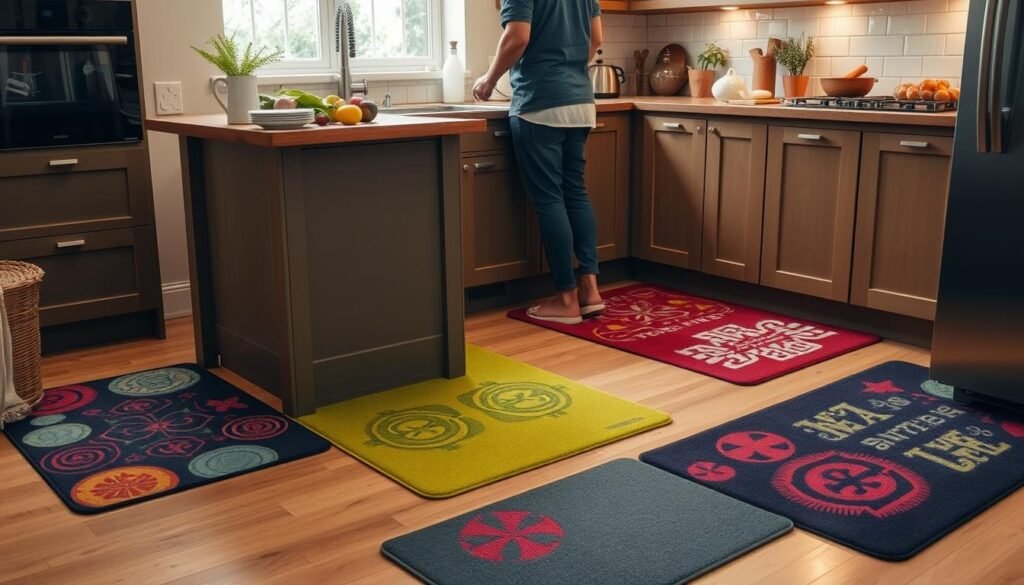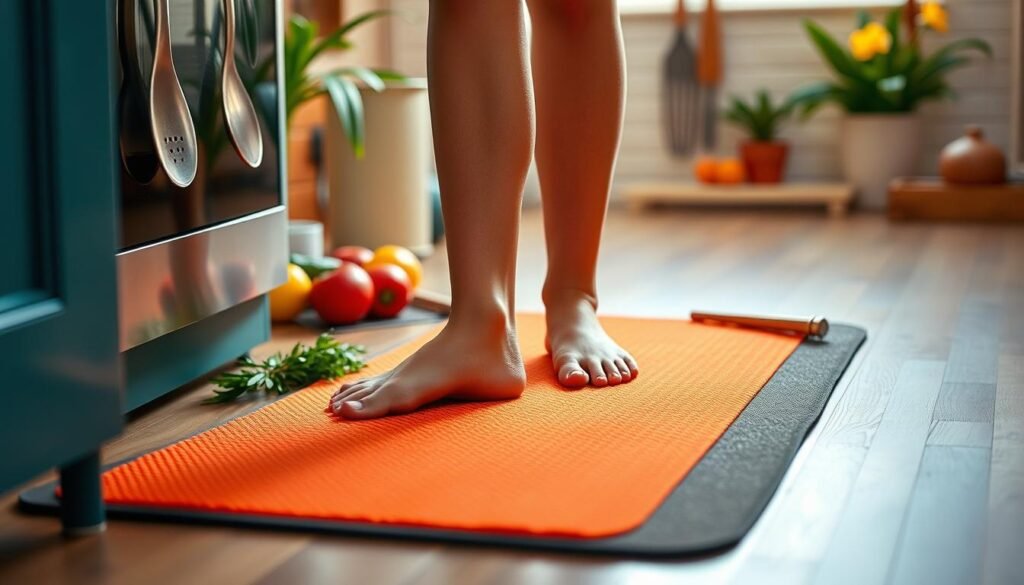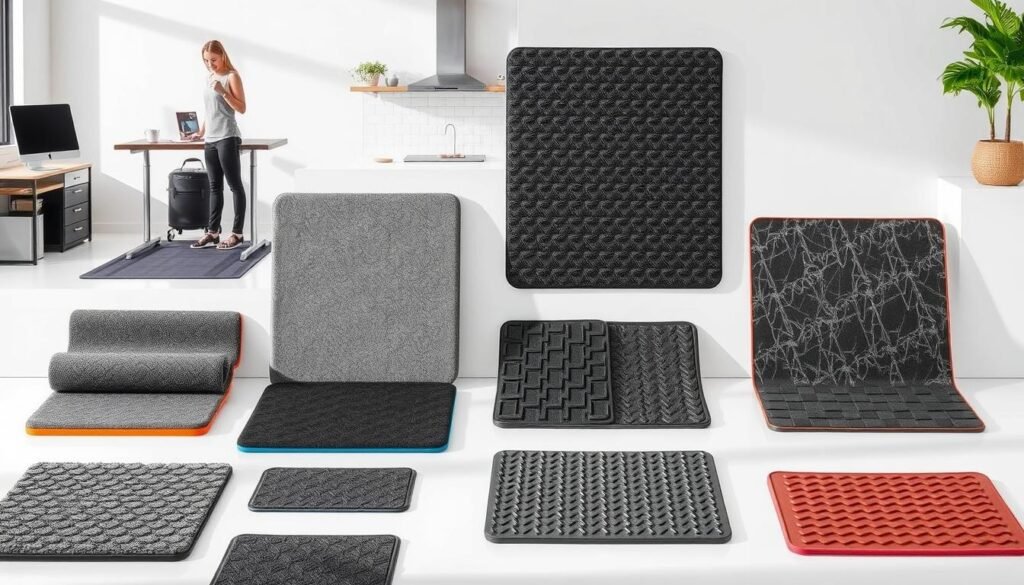Did you know that musculoskeletal disorders (MSDs) caused about 7.3 million lost working days in 2021/22? This big number shows how much prolonged standing can hurt our bodies. Especially on hard floors like concrete. Anti-fatigue mats are here to help. They are made to lessen discomfort and tiredness. By providing a cushion between your feet and the ground, they help improve blood flow and lower muscle strain. It’s impressive that more than 82% of employees feel more productive after using these floor mats.
The story of anti-fatigue mats began in factories, but now they suit many places. They’re perfect for both work areas and creative spots at home. With many materials, sizes, and thicknesses to pick from, finding the right mat can make standing for long periods much more comfortable. These mats not only ease discomfort but also make workspaces safer, one step at a time!
Key Takeaways
- Anti-fatigue mats are designed to alleviate discomfort from prolonged standing.
- They are effective in promoting blood circulation and reducing muscle fatigue.
- Hard surfaces, like concrete, increase the risk of musculoskeletal disorders.
- Quality mats can ultimately lead to improved workplace productivity and employee comfort.
- Different materials and thicknesses cater to various work environments and personal preferences.
Understanding Anti-Fatigue Mats
Anti-fatigue mats help reduce the discomfort caused by standing for too long. They’re different from regular mats because they let you move naturally. They also soften the impact on your joints and muscles. These mats are made of foam, rubber, or vinyl. Each type has its own benefits and is best for certain places.
Standing too much at work can lead to big costs. It can cause less work done and more days missed. Premium anti-fatigue mats can cut down fatigue by half. This is huge because standing takes more energy than sitting. Choosing the right mat, with the perfect amount of softness, is key.
Nitrile rubber mats are a great pick for many jobs. They are better than PVC mats because they don’t slip and last longer. PVC mats can get damaged and dangerous in wet places. On the other hand, polyurethane mats work well in damp areas. Yet, they might not hold up in very tough conditions.
| Material | Durability | Slip Resistance | Cost | Ideal Use |
|---|---|---|---|---|
| Rubber (Nitrile) | High | Excellent | Moderate | Industrial and wet environments |
| PVC | Low | Poor | Low | Low-foot-traffic areas |
| Polyurethane | Moderate | Good | High | Semi-damp conditions |
When picking mats for standing desks, think about how and where they will be used. This helps ensure they reduce tiredness and keep you comfortable. Changing mats that are old and worn out is also important. This keeps workers feeling good and safe.
What Are Anti-Fatigue Mats?
Anti-fatigue mats are designed to reduce discomfort and fatigue. They are useful for people who stand for a long time on hard floors. These mats have a cushion-like surface. This surface helps with small leg and feet movements. Such movements boost blood flow and make standing more bearable. Studies show that these mats can cut fatigue by up to 50% for those using them.
These mats come in different materials, like foam, gel, and polyurethane. The choice of material, texture, and thickness depends on the work setting. They are used in places like workshops, stores, and homes. Some mats even have massage dots for extra comfort and safety benefits.

Anti-fatigue mats help lessen joint pain, varicose veins, and muscle stress from standing long. They encourage good posture and slight movements. Such benefits can improve work productivity. When looking for the perfect mat, here’s a helpful link: finding the best anti-fatigue mats.
The Benefits of Using Anti-Fatigue Mats
Anti-fatigue mats bring significant benefits to workplaces. They help with employee well-being and make businesses run smoother. Many companies use these mats where employees stand a lot. The mats reduce tiredness and make the workplace more comfortable.
Reduced Discomfort and Fatigue
These mats decrease the strain from standing long hours. Standing uses about 20% more energy than sitting, which increases tiredness. Workers standing on hard surfaces feel discomfort in feet, legs, and back.
Comfort mats provide cushioning, easing pressure on feet. This leads to less interruption and better focus at work. Using them can cut tiredness and discomfort by 50 percent, boosting productivity.
Improved Circulation
Anti-fatigue mats also enhance blood flow. The gentle movements they encourage help prevent issues like deep vein thrombosis. Studies support that these mats, along with other ergonomic practices, reduce back and leg pain.
A review found that softer flooring helps those standing for long. It eases musculoskeletal discomfort.

But there’s more than just employee health. These mats also lessen work absences due to pain. Some businesses saw a one-third decrease in absenteeism. Using these mats fosters a healthier work environment for everyone.
Want to know more about these mats? Check this article on the importance of anti-fatigue mats. They’re a smart solution for modern workplace issues, enhancing employee health.
Types of Anti-Fatigue Mats Available
Choosing the right anti-fatigue mat means knowing the different types of anti-fatigue mats out there. You have options from strong rubber for industrial anti-fatigue mats to soft foam for your home. Each material has its own benefits for comfort and use.
Material Choices
Several materials are used for anti-fatigue mats. Each type helps prevent tiredness from standing too long. Here are some top picks:
- Foam: Offers a soft surface, ideal for places like kitchens and retail spaces.
- Rubber: Provides exceptional durability, perfect for industrial anti-fatigue mats.
- PVC: Generally used for its ease of cleaning and resistance to chemicals.
- Carpeted Mats: Adds warmth and comfort, suitable for home environments.
Size and Thickness Considerations
The size and thickness for comfort mats are key for the best effect. Thicker mats over 5/8″ give better support. This helps lessen the strain on your feet and joints.
A variety of sizes fits different spaces well. This makes sure the mat covers enough area, like in a busy kitchen or workshop.
For instance, the Soft Cloud Foam Comfort Mats range from $92.00 to $200.00. They meet various workspace needs.

Getting to know these types helps you choose wisely. Especially when you want a mat that cuts down tiredness by 50%. It really boosts comfort during long stand-up hours.
How Do Anti-Fatigue Mats Work?
Have you ever wondered how anti-fatigue mats help people who stand for long hours? These mats use a special technology to make a soft surface. This surface lets your legs move a little, helping blood flow better. It also works your muscles and spreads your weight over your feet.
Standing on these mats feels good because they soak up shock and cushion your feet. They cut down on pain and prevent problems that come from standing a lot. Studies show they can really help with lower back pain. This makes them key for staying safe and feeling good at work.
Anti-fatigue mats also have anti-slip surfaces for extra safety in busy spots. Just standing for 90 minutes can make you stiff and sore. But these mats can cut your tiredness in half and keep joint and heart problems away.
These mats are also good for saving money on health care and missing less work. They boost how much work gets done because everyone feels better. You can find them made of rubber, gel, or PVC foam, depending on what you like. Picking the right one means you can focus more on work and less on being uncomfortable.
| Mat Type | Support Level | Price Range | Applications |
|---|---|---|---|
| Rubber Padded | High | $$ | Residential, Commercial, Industrial |
| Foam | Moderate | $ | Workstations |
| Gel | Soft | $$$ | High Comfort Areas |
| PVC Foam | Moderate to High | $ | Workplaces, Home Use |
Choosing the Right Anti-Fatigue Mat for Your Needs
Choosing the right anti-fatigue mat requires looking at several key factors. It’s important to check the work area first. The type of floor and work tasks affect how comfortable you’ll be standing for a long time.
Evaluating Work Environment
Different work environments need different kinds of mats. Places that are often wet or oily need mats with better grip. In areas like industrial kitchens, mats must withstand harsh chemicals and stay durable.
Importance of Grip and Durability
Grip and durability are key when picking anti-fatigue mats. The right mat can prevent accidents in busy or hazardous areas. Quality mats keep their shape and support, while others wear out quicker. Look for mats with sloped edges and good cushioning for more comfort.
Common Applications for Anti-Fatigue Mats
Anti-fatigue mats are key in making places more comfortable. They help both businesses and homeowners. They reduce discomfort and boost productivity when standing for a long time.
Different places use anti-fatigue mats, from tough industrial sites to cozy homes. This shows their wide range of uses.
Workplace Use and Industrial Settings
In places like factories, anti-fatigue mats keep workers comfortable for hours. Workers in manufacturing, retail, and healthcare gain from these mats. They’re made for areas with lots of foot traffic. Some key places they’re used include:
- Factories and assembly lines
- Cashier stations in supermarkets
- Food service areas
- Medical facilities where staff stand for long hours
A study showed a 2.2% rise in productivity at a big car factory with these mats. This change improved safety. It also cut down on missed work days by 20% over a year. These gains show why it’s smart to invest in good-quality mats.
Home Use and Creative Spaces
Comfort mats are also popular at home, especially in kitchens and craft rooms. These mats help people stay comfortable while cooking or doing crafts. Reports say:
- Home kitchens with these mats see 60% less leg tiredness.
- 90% of people with standing desks feel more comfortable.
Anti-fatigue mats fit various uses, in both work and home settings. Picking the right mat means looking at materials, surfaces, and how you’ll use it. This way, users get a lot of comfort from their mats.
| Setting | Application | Benefits |
|---|---|---|
| Industrial | Assembly lines | Increased productivity |
| Retail | Cashier stations | Reduced absenteeism |
| Healthcare | Nurse stations | Improved employee morale |
| Home | Kitchens | Enhanced comfort |
| Home Office | Standing desks | Decreased leg fatigue |
Conclusion
Anti-fatigue mats offer comfort and boost productivity for people who stand a lot. They are crucial in many areas like Manufacturing, Healthcare, Retail, and Hospitality. These mats lessen discomfort and aid in better blood flow, making work and home spaces better.
There are different kinds of anti-fatigue mats, including Foam, Rubber, Gel, and Modular types. Each is designed for specific situations. Choosing high-quality mats from places like phs can make a big difference. They enhance ergonomics and safety, which makes people more satisfied and productive at work.
Choosing the right anti-fatigue mat can make your day more comfortable and efficient. To learn more about their benefits, check out this resource. Using these mats can significantly improve health in work and home environments.